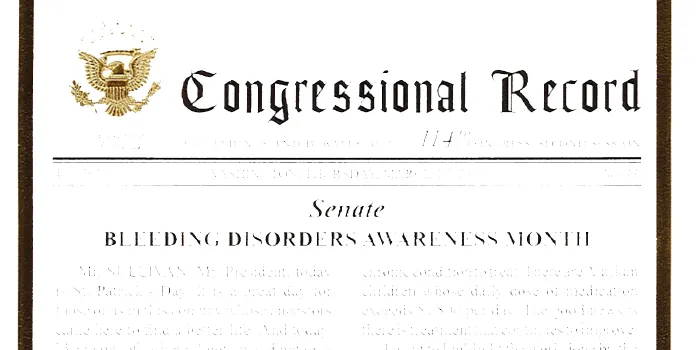The National Hemophilia Foundation (NHF) celebrates its 75th anniversary in 2023. Throughout the year, HemAware.org will be commemorating this special milestone with articles that look back at notable programs, initiatives, and events in NHF’s history.
National Bleeding Disorders Awareness Month is here again. Every March, NHF, its chapters, and community members bring attention to inheritable blood and bleeding disorders, highlighting those who live with them and their stories, experiences, struggles, and triumphs.
This year’s theme, “Start the Conversation,” highlights the importance of elevating conversations around bleeding disorders, from research and treatments to mental health and advocacy efforts.
Creating Action Through Awareness
Bleeding Disorders Awareness Month was established in 2016 when the Department of Health and Human Services (HHS) approved its inclusion on its National Health Observances calendar. Before this designation, there was Hemophilia Awareness Month, established by the Reagan administration in 1986.
According to Nathan Schaefer, NHF’s vice president of public policy, the new designation in 2016 was an effort to be more inclusive and more accurately reflect the wider bleeding disorders community. Though it doesn’t come with legislation or federal funding, Schaefer says that establishing Bleeding Disorders Awareness Month has made it easier for NHF’s advocates to educate elected officials about bleeding disorders and what people in the community go through, and to present solutions to them on how to better serve those with bleeding disorders. An official recognition of Bleeding Disorders Awareness Month put NHF’s community on the federal government’s radar.
“To acknowledge officially that people with bleeding disorders exist and have a right to be recognized by government bodies that structure health care programs,” Schaefer says. “It affords an opportunity to make connections with policymakers, and with those connections our advocates can go back to elected officials and work with them on solutions.”
Read More: 6 Ways to Celebrate Bleeding Disorders Awareness Month
How Federal Recognition Inspired Local Advocacy
Bill Robie, NHF’s director of state government relations, says Bleeding Disorders Awareness Month has “really been a catalyst for state advocacy efforts for chapters. Launching it at Washington Days was significant in that we had this national effort that I think excited the community and energized them to do advocacy [work].”
Robie says many chapters saw what NHF was doing to raise awareness at the federal level and brought that to the state and local level, urging officials to make proclamations to officially recognize Bleeding Disorders Awareness Month locally. In turn, local chapters had the impetus to build connections with governors and local policymakers. Then as challenges in the bleeding disorders community arise, such as insurance companies prohibiting people from accessing all available clotting factor therapies, NHF chapters already have an elected official who knows them and understands the community’s needs.
Plus, the campaign made advocacy more approachable to community members who might otherwise be intimidated by advocacy work. Campaigning to recognize the awareness month locally gave advocates a goal that could be accomplished without a large budget and didn’t involve controversial subject matter.
“It gave our advocates something tangible to set as their goal,” Schaefer says. “It’s really just about getting on an elected official’s radar, and for advocates, particularly those who are new to advocacy, having a concrete goal and getting a physical copy of the resolution makes them feel very accomplished.”
Read More: How Can You Be an Advocate for the Hemophilia Community?
The Inception of the Red Tie Challenge
Bleeding Disorders Awareness Month also brought about the Red Tie Challenge, which is NHF’s campaign to advance the fight against bleeding disorders by raising money for its research, education, and advocacy initiatives. The challenge, launched during Bleeding Disorders Awareness Month in 2017, called on participants to donate to RedTieChallenge.org, then share photos or videos of themselves wearing a red tie using the hashtag #RedTieChallenge.
“The Red Tie Challenge was and still is associated with Bleeding Disorders Awareness Month — to wear a red tie in recognition of the month and speak about their connections to the bleeding disorders community,” Schaefer says.
Read More: 5 Ways to Celebrate Bleeding Disorders Awareness Month at School

